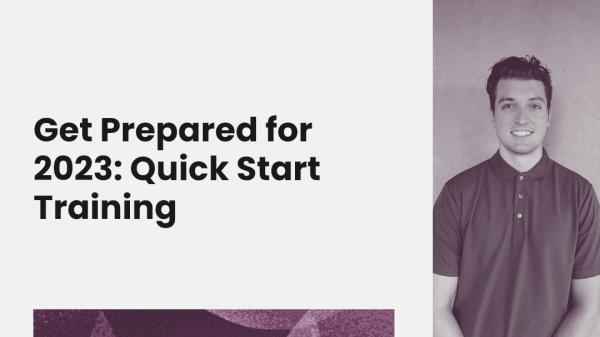Date: Friday, December 16, 2022
Time: 1:00pm Eastern / 10:00 am Pacific
Presenters: Derek Devashrayee, Customer Success Manager
Watch this 30-minute quick start overview, including tips and tricks for how to get the most out of your 360 feedback initiatives
This webinar is extremely useful for people seeking a refresher on how to use Spectiv more effectively, and for organizations bringing on new team members to work with the platform.
Transcript
Speaker 0 | 00:01
All right, so the reason I wanted to hold this is there are three main touchpoint for admin on the spec platform. The first is uploading participants, the second is supporting the participants and or raters through the process. And the third is sending reports. It’s making sure those reports end up in the right hands at the right time. So as we go through the agenda today, I’m just gonna go over some quick start expectations and then I’m gonna loop back to those three main touch touchpoint and make sure that everyone feels comfortable with those three main touch points of being able to add an admin to the platform to help out with the 360 process. Perhaps it’s just been a while, or perhaps this is the first time you’ve seen the, the platform in general. Uh, we’ll go over how to make those decisions on which assessment is best for you, which upload method is best for you, and then ultimately the start date.
Speaker 0 | 01:02
The platform will take care of the rest after that for you. Um, next is the dashboard overview. I’ll show you, uh, your perspective of the platform and then I’ll also show you the perspective of the participants and or raters. Third, we’ll move into distributing the report. I’ll show you how the platform can help you with that and or how you can download and send those manually yourself. And then lastly, just showcase our resources and the help site. So when you go through onboarding respective, and part of what I’ll go over today is typically what we would hold in a kickoff call is we decide which assessment we decide the upload method. Now, the phase one, the platform onboarding quick start is mostly what I’m going to cover today. Now I plan on also covering phase two, the customization and the pre-launch checklist in upcoming webinars over these next few months. So as mentioned today is more of a dashboard overview. I’ll showcase user experience. I’ll explain rater groups, how to add participants, the utilization of tags, and just a quick help site review you.
Speaker 0 | 02:13
So the 360 process, the first step that we need to take is decide which assessment are we going to have the participant go through. Now, let me pull over a resource here real quick that showcases the three different options we have or you have. So let’s see here. There we go. So we have our three off the shelf foundational assessments. We have our executive leader, our business leader, and our individual contributor. So at the very least, if you wanted to log into spec, you could choose one of these tried and true, one of these three foundational assessments. Now, why do clients take this, take this route. Well, they’re built for you. They are ready to go. They have hun we, we’ve ran them for hundreds of organizations. We have benchmarks available, they’re great. That’s the first option. The second option is we have a library of 80 different competencies that you can choose from.
Speaker 0 | 03:18
That means you can draw from a total of 320 items. And with the professional level access to the platform, you have the ability to create your own library of these competencies and then build your own assessment from those competencies. So if you’d like to create your own assessment, you can easily draw and from our competencies and create a a ready to go assessment. The third option is full customization. Now, that might be working with one of our awesome consultants that might be inputting your own competencies, and that is definitely a route you can take. However, with that route, you would then be pulling from possible pot, um, future benchmarks from your own data. So those are the three steps you can take today. I’ll mostly be going over just using our off the shelf assessment as the customization will be more, will be covered more in our next webinar.
Speaker 0 | 04:13
So let’s jump back here. The next one is participant selection. And actually here’s a, a resource. All these resources as mentioned are available on the help site, and I’ll make sure you know where to find them. So you need to make the decision. How are we going to upload participants? Are we just going to have all of the raters preselected and we’ll put the participant and all the raters in the platform. Then if that’s the case, you’ll jump right into feedback collection. And that process is typically about 10 business days, two weeks. We have another option where we allow the participant to select their raters and then we jump into feedback collection for 10 days. We have a third option where we allow the participant to select their raters. There’s an added layer of approval, whether that be from their supervisor, manager, one of you.
Speaker 0 | 05:05
And then we jump into feedback collection. So we have three different routes you can typically take. We also have a hybrid option where you can lock in. I know their supervisor, I know their peers, at least some of their peers and I know their direct reports. But then we allow the participant to select others or or other peers. So those are the first few decisions you’ll need to make is which assessment are we going to run and what method are we going to use to upload our raters. So let’s jump to the platform. So if we’re looking at the platform here, this is a quick dashboard overview. We can see that we have the queue. That’s where you can upload any participants at any time. Um, getting them ready to launch. We have rater selection.
Speaker 1 | 05:56
This is if we allow the participant to select their raters. We can monitor them in here, see who select their raters rater approval. This is if they’ve already selected their raters. And the approver, um, is going to either edit or, or approve. And I’ll showcase all this. And then feedback collection. This is where the participants will spend most of their time. This is where you’ll probably need to spend the most attention or, um, focus on the most is, okay, what are our participation rates? How are we doing with deadlines? And then we have the reporting phase. This, these are the completed assessments. We have coaching, coaching is another question for another time, but you can ultimately, um, upload internal coaches into the platform and the coaching app can take care of sending the report and scheduling with that coach, either through decision-wise or internal coaches.
Speaker 1 | 06:48
And then the complete phase is where we just like to harbor all of the completed assessments, and that’s where we can start pulling group reports from. So the touch point I want to focus on is when you come in here, you’ll have these three options, pre-selected, pre and self-selected and self-selected. So the platform is very intuitive, and in this example, we have a directory uploaded on the backend, which makes it very easy. But I can easily come in here and I can type in Brian Diaz is going to take, and then I just choose from possibly one of these three off the shelf assessments. Possibly you created a couple others, I’ll just choose the business leader. All you need to decide is the start date. The timelines are built in as defaults in the, in the backend. They can be altered. And then very simply, you can come in here and add as many raters as you would like.
Speaker 1 | 07:40
For example, I could say Margaret Adams is the supervisor, and you can very easily come in here and select as many participants, excuse me, as many raters as you would like for Brian Diaz. And then as you can see, it shows up here. Now, as you can see these, the self and the supervisor are typically required. Other rater groups are are optional. Now, you can make all rater groups required if you would like, but the rest are optional. But they do need to hit a minimum of two. So as, as you can see here, we’ve only uploaded one peer. It’s not gonna let us move forward. This add button won’t highlight unless I go ahead and, and add another peer. Then we’ve hit that minimum and we can then move forward. So that’s the preselected, very simple. And here you can add tags. Let’s say Brian was running this in January of 2022.
Speaker 1 | 08:37
I can easily go ahead and add that tag. I can add a tag of Brian’s a Brian’s in the finance department. Tags are very helpful as we go through. As you can organize people in, um, you can organize the participants in any of the phases and employing group reports. You can get really granular and say, I wanna pull group report from everybody that took the foundational business leader assessment that had the tag of finance, and they’re also part of the January cohort. So anyways, that’s how tags can be very helpful for you. So that’s the pre-selected route. You can also go the self-selected. So very simple for you. All you need to come in here is enter in Brian Diaz, select the assessment start date, and then if you would like to add an approver, you can. So once again, Margaret was the supervisor. Um, and then once again, we can add any tags and hit add.
Speaker 1 | 09:31
So very simple process. This is where Brian would then be able to select his raters. So I just wanna showcase this side of it, this side of it for you. So if Brian were to select his raters, this is the landing page that Brian would have once he’d received an email from us, a emailed default templated email. And from here Brian can say, okay, I’m gonna add in everybody. Margaret, if we remember is the supervisor. We can say, John is a peer and it’s very simple for Brian to come in and select all of his Raiders. Also from here, once Brian has selected his Raiders, um, let’s just say this for this just for Patricia Wood at this point, and approver can be added to the participant. So Patricia Wood has already selected her raters. Now I, as the approver, can come through and add any other raters.
Speaker 1 | 10:28
I can edit any of these and say, oh, you know what, John Brooks really doesn’t work super closely. I’m gonna go ahead and edit that, and then I might add a few more direct reports and then I can approve. Um, so a very simple process for any approval on here. So that’s how it would work if we allowed them to select their own participant, excuse me, their own raters and there were a layer of approval. Now the third option is a hybrid option, and all of these can be uploaded through, uh, CSV files as well as the, the platform’s very easy to use, but also showcase real quick how the CSV files would need to be filled out for these. So in here, as you can see, there’s a lock icon. So let’s say we’re gonna add in, once again Margaret Adams supervisor, I’m gonna lock in all of the people that I’m sure of and I can even possibly suggest some without locking them in.
Speaker 1 | 11:26
So I say, you know what, John Brandon Johnson, for example, is an other I’m going to suggest, but without locking it in, then we allow Brian when he’s selecting his Raiders to then make any adjustments. So, um, I think that’s about all I wanted to show from here. There are CSV files that would need to be filled out. So for example, if all of the raters are preselected, you can fill out as many as you would like, um, into the CSV file and upload. So if I fill out that CSV file, I just go to preselected, I would go to upload, and then from here I can upload the file that I have. It’ll auto, uh, select all this information. And, um, it looks like we need to figure out the rater groups, uh, for this executive leader, we’re, we’re seeing an issue. So let’s jump to that.
Speaker 1 | 12:23
So if we go to the assessments, under each of the assessments, we can select specific rater groups that are going to be available. So we can come in here and we can customize. This is one touch point the admins run into is, um, the rater groups need to be exactly what is in the CSV file for upload. So I can say, okay, I want direct reports, I want, um, you know, peers, others, I’m gonna jump to this business leader one real quick so you can see the differences. So with rater groups, we can mark these as is required. We can also change, I probably don’t wanna do that with direct reports, but we can also change the minimums. So now that I’ve marked these as required and I’ve changed the minimum, if I come back to the dashboard or in rater selection, we can see, let’s take Michael Brooks for example. I’m gonna pull this link up.
Speaker 1 | 13:27
We can then see that the verbiage changes. So instead of you may add two or more raters, the verbiage is now going to say you must add four or more raters to the peer group, or you must add two or more raters to your direct report group. So just keep that in mind as to the route you want to take. Typically, I only mark them as is required if we’re allowing the rater to select their own. So then the rater knows, Hey, I, I need to add X amount of raters for each rater group. Whereas if you are launching it on your own with preselected, you’ve probably already made those adjustments and made sure that the correct raters are going to be included. So that’s just one thing I wanted to show with the groups. Um, and then as with each stage, you can easily see, okay, who has completed it, who hasn’t, who’s passed the deadline, whose deadline is coming up for any of the participants, you can come to details in here and see who has been selected.
Speaker 1 | 14:26
Um, you can alter the timeline for the current phase they’re in. Let’s say we wanted to give, let’s say we saw everyone that’s overdue right now, we can filter and we can say, everyone that’s overdue, I’m gonna select all and I’m going to adjust their rater selection deadline. I’m gonna give them until Wednesday of next week. So the, the platform is very easy to either make adjustments for individuals or you can make adjustments for groups all at all at the same time with the bulk options. So once we’re in feedback collection, there are several different views you can use. So for example, for Brittany Morris, I can look at the participation, we’ll use Nancy Scott for this example. Today we can see, okay, Nancy is a crucial rater. Charles is a crucial rater. Crucial means that we have to hear from the minimum amount of Raiders for that group, for the platform to say, okay, today’s the deadline.
Speaker 1 | 15:26
We’ve heard from the minimum amount of crucial raters, we’re going to move this forward to the next phase of reporting where the report is generated and available. So some clients like to mark all of their raters as is crucial to ensure that they meet the minimum amount of raters for each rater group. Others don’t wanna hold up the process. If we don’t hear from that fourth peer, that’s okay. We’ve heard from three. So it’s really up to you on, um, the minimums and who is marked as is crucial as that’s kind of a break in the process for the feedback collection before the system moves into reporting. So for example, I can come in here, I can say, okay, Maria Lewis, I’m gonna send Maria a reminder. Reminders are defaulted to Monday, Wednesday, Friday on the platform. So reminders have been sent out, but I’m gonna, I’m gonna check on Maria here real quick and see what’s going on.
Speaker 1 | 16:17
So we can come to Raiders, we can type in Maria Lewis, we can confirm. Okay, yep, this was for Nancy Scott and we can send Maria a reminder. We can also, if we need, we can send Maria a direct link so Maria can from here, um, take the assessment for Nancy. So it’s a very simple process. All they need to do is follow the link in the email and take the assessment. Um, if they are taking it for several, as you can see, it’ll, they’ll all line up in here with the different due dates and they can begin the assessment as oftentimes running a cohort through. They might be taking it for several people at the same time.
Speaker 1 | 17:04
So we’ll jump back to the dashboard. Lemme see if there’s anything else I wanted to showcase on this page. As always, you can select several or all we can add tags. Let’s say, you know what we forgot to add the tag of this is a group all from our HR team. We can add the tag of HR very easily. And as you can see that’s now been added to this group. Um, you can pause participants. So let’s say that Eugene, we reached out, we, we totally forgot Eugene is on leave right now. We don’t wanna blast emails to Eugene and all of his raters. We can come in here and pause the assessment for Eugene. So that means that no emails will be sent out. The link will not be active until we unpause it from here. Just show you the rest of the options.
Speaker 1 | 17:53
You can also manually move participants through each phase. So lemme jump back to the dashboard here. So let’s say we’re in rater selection. You could come through filter and say, everyone that’s complete, I’m just going to move them to the next phase. You could do that. Now, moving them to the next phase will then say, then the platform will say, okay, what, whatever their next phase is. And I would assume it’s radar approval or feedback collection, depending off if someone’s going to approve for them. And we can check on that, right? So there’s no rater approval for Ashley Watson. So Ashley’s gonna jump right into feedback collection. She’ll have 10 days from now to, um, have all of her raters give her feedback. Or for these with approval, um, with approvers attached, they would then jump in the Raider approval phase. They would have three business days for their approvers to approve and then jump them into feedback collection.
Speaker 1 | 18:49
So the nice part about it is you can move raters manually through the process. However, for the, for a hands-on experience and to typically keep cohorts together, the system is built to check for the deadline and for completion. So for any of these phases, if the participant has completed that phase or they’ve received enough feedback or they’ve received approval, then the system will say, okay, today’s the deadline. I’m gonna check for approval as of tomorrow morning, they’ll be moved to the next phase if it, if it’s completed. If not, then as you can see here, um, let’s jump back here.
Speaker 1 | 19:29
Oh, I guess I adjusted the deadlines for those that were late. But anyways, they’re gonna stay in that phase until it moves forward. So, um, let’s see. Feedback collection. Ah, yes. So at any point in time if you wanna go to details, you can add in a rater manually as admin. So you have, you have full capabilities to come in here and add anybody that was potentially left out. Let’s say you need to alter a, a person in their rater group. You know what, Tyler Meyers is actually more of an other rater rather than a peer. I wanna have at least three other raters in this rater group. The best practice is to have about three to five raters for each rater group, by the way. So, and, and to keep the minimum at two. So we have a little bit of buffer room to ensure that we receive enough participation and we can showcase each perspective from each radio group on the report.
Speaker 1 | 20:24
Um, now let’s say someone’s been moved into reporting but they actually didn’t receive all of the participation we were hoping for. As you recall, I just raised the minimum for peers to four and the direct report minimum is set at two. Let’s see, that’s being a little slow, so I’ll just jump to the complete phase. Um, so from here on the report, it’s not gonna showcase these two specific rated groups ’cause they haven’t hit the minimums that we’ve decided on. So I might come back to assessments business leader, uh, yes, I forgot I I had set that to four. I’m gonna go ahead and set that down to two. So now if I come back to the dashboard I come to complete, we can see that we’ve now hit the minimum for that specific rater group. And if we view the report, we can see the different, uh, sample page being a little odd, but we can see the different rater groups and their perspectives.
Speaker 1 | 21:18
Um, from here, once they’re in reporting and or complete, you can download the assessment and send that uh, to the participant. You can also use the platform to send the, uh, to send the reports for you. So let’s say we wanted to send Emma her report. I also wanted to add in an HRBP with their email. All I have to do now is hit send report. So it’s a very simple process rather than downloading reports for everybody, sending them manually. And if that’s your process, that’s great. You can also download all of them as a zip file. You can select all this is where, once again those tags come in handy. You can say, okay, I’m gonna select everybody, um, from a specific cohort, filter that through, and then you can hit send report emails. I can send the reports to the participants, to their supervisors and or anybody else with, which is with just a few clicks.
Speaker 1 | 22:11
So it’s a very simple process to send out the reports for you as that can become a bit burdensome with a lot of participants. So let’s see here. Lemme make sure I’ve covered all that I wanted to. The three main touch points are the uploads. We have sample files that are ready to go for you. Um, that’ll showcase whatever route you decide to take. Happy to share those. Um, I’ll upload those to the help side as well. Um, for you, you can also just use the platform. It’s very intuitive and easy. Typically when you’re uploading, you know, a few more than a few participants or if you’re, or if you’re uploading all our raters, I like to use the CSV files as it’s saved there on the CSV file. I can alter and then I can upload when I’m ready. Um, I just wanna showcase the help site real quick.
Speaker 1 | 23:04
So the help site mirrors the platform. So if you had any questions on, okay, how did we launch participants, again on the help site, you can go adding a participant. Uh, I liked what Derek talked about with the self-selected raters. I just want to enter in the participant and have them select their own raters. In here. There are video tutorials as well as it’ll walk you through the different stages. We also have a resource library. So if you come to the resources in here, um, a lot of the resources I’ve showcased today are available here. Lemme just do a quick overview of them. We have the 12 ways to use 360 feedback, 360 assessment selection. That’s the one that I showcase briefly on which route might be best for you. We have our foundational assessments, um, in, in the foundational. I should wanna showcase that real quick.
Speaker 1 | 23:52
We have, if you’re looking at trying to make a decision, um, you have the ability to compare these three assessments either by competency that’s utilized and or the, the derailers I suit that are utilized. And it also has all of the questions, all the competencies. One thing to note is the results orientation, for example, is in each of these assessments, but it’s going to be different ’cause these assessments are tiered. So results orientation for an an executive leader’s going to be different than for an individual contributor, but there will be some overlap. Uh, lemme jump back to that help site real quick. Reading your report, this is helpful in helping participants interpret their report report customization. We’ll go over that more in the next webinar of how to decide which modules you want included on the report, we have sample and internal communication, which can be very helpful in increasing participation rates, whether that’s you reaching out as, you know, HR leaders to the participants and or having the participants reach out to their raters.
Speaker 1 | 24:51
We have some templated, um, communication for that. Anyways, I, I won’t go over too much of this, but the help side is incredibly, hopefully helpful for you. And is there as your first resource as always, me and my team will get back to you as soon as possible with questions, but oftentimes a quick five, 10 minute read or brush up from the help site will, will answer your question. Uh, let’s jump back to the agenda to make sure I’ve covered everything. Best practice. One more thing is to send out the reports 24 to 48 hours prior to the debrief. Um, the reason we do that is the participant gains an early hypothesis of, okay, here’s my report. They can go back to it maybe one or two times, but they’re not sitting on possibly a comment they weren’t expecting or a score they weren’t expecting for weeks prior to their debrief.
Speaker 1 | 25:46
They are more open-minded. They haven’t come to a conclusion of what all the data means. And so anyways, we as that last stage, right, the, uh, platform can be great, can be easy to use, intuitive, smooth process, but if the participant doesn’t get the report they need and isn’t able to create actionable items, then the rest of the process, right? That’s the outcome that we’re looking for. So whether it’s you, we, we offer certification courses for, um, admin and or any other coaches in your organization to go through a 360 coaching certification with us. We offer individual debriefing, we offer group debriefing, or if you’re gonna do all the coaching internally, that’s great. We just know that that last step is essential to the participant’s development and growth. Um, just wanted to, uh, preface and you can put it in on your calendar.
Speaker 2 | 26:43
Um, and we can put in a link in here as, as well as, as in the follow up email to the next webinar. We’ll be going over customization of the assessments, going over, customization of emails, your reports, and also some of the default settings in the background. Um, if you have any questions, put them into the chat. You can always reach out to me as well and or any of my team if, if they are your, uh, lead customer success manager or CSM. It’s been great having everyone on this onboarding today. Once again, this is recorded. We will be sending out a link to this recording. Please feel free to share with anybody on your team that might be joining, um, that you would like to have help you with running cohorts in 2023. Someone that might just need a refresher. Really appreciate everyone jumping on seeing these, these comments come in from people I’m, I’m working with. Really appreciate it and I’ll go ahead and wrap this up if we don’t have any other questions. Thank you so much for joining today, uh, for spending time. Be sure to sign up for the customization webinar coming up soon. Thanks. Bye.




